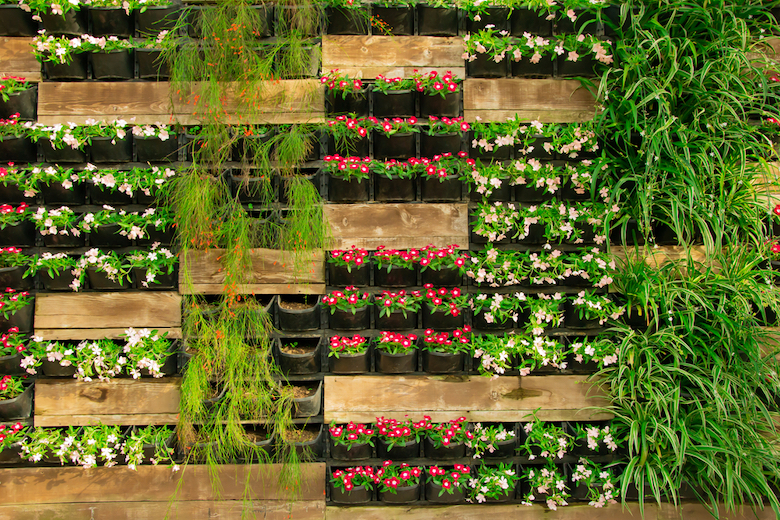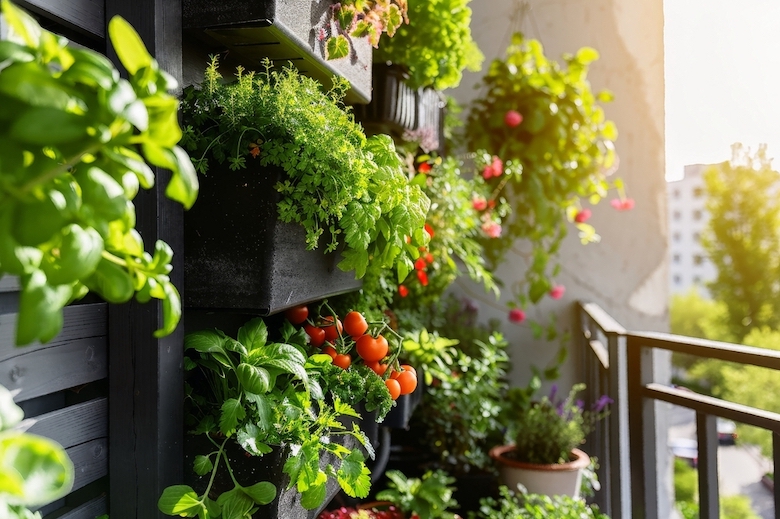You don’t need a large garden or allotment to enjoy fresh flowers and home-grown veg. This guide takes you through the best ways to garden in small spaces, from your patio to your porch, with plenty of handy tips along the way.
Growing upwards, or ‘vertical gardening’, brings a new dimension, to your gardening allowing you to create stunning effects and harvest a surprising amount from your space however small it may be. Here’s our guide to vertical and small-space gardening.
Why try small-space gardening?

Image: Shutterstock
Gardening in a compact space has a surprising number of benefits, from aesthetics to improved harvests:
- Perfect for any sized space. Container and vertical techniques allow you to create a garden on any patio, balcony or doorstep, meaning you don’t need a traditional lawn or flowerbed to get started.
- Looks beautiful. Well-designed vertical gardens and container collections can look stunning, mixing lush foliage with colourful flowers and produce.
- Creates height and interest. Use vertical planting to divide your garden into separate zones, to hide ugly walls, or to bring a feeling of seclusion to your plot.
- Deters pests. Plants grown away from the ground in containers and hanging baskets have less chance of being attacked by slugs, making fruit and veg growing more productive.
- Environmentally friendly. Vertical gardens provide habitats for insects and help improve urban air quality. A ‘green wall’ could even help cut down on energy costs by further insulating your home.
Top tips for small-space gardening

Image: Shutterstock
Think creatively, and make every inch count. Creating a welcoming and productive space isn’t complicated. Check out these ideas:
1. Master the art of container gardening
This is the foundation of nearly all small-space gardening. Getting comfortable with pots and containers allows you to grow almost anything, anywhere.
- Choose the right containers. Your choice of pot is key. Use deep pots for root vegetables like carrots, troughs for salads, and don’t be afraid to mix different sizes and materials to create visual interest.
- Think of your patio as a stage. Arrange your pots on plant stands, shelving, or even an old stepladder. Group containers together and create different levels to make a more elegant and impactful display than just dotting around single pots.
- Use grow bags and raised beds. For bigger harvests, flexible grow bags are perfect for crops like potatoes and tomatoes. If you have the room, a small raised bed can act as a self-contained and easy-to-manage veg patch.
2. Garden vertically – the ultimate space-saver
Once you’re comfortable with containers, growing upwards is the next step to maximising your space for both flowers and food.
- Use frames and supports. Some vegetables climb naturally. Runner beans, French beans, peas, squash, and climbing tomatoes will happily scale a frame, obelisk or trellis.
- Train plants against a wall. Cover a wall with climbers, wall shrubs, or train fruit trees as espaliers. Pears, apples, and currants will all thrive trained against a sunny wall.
- Use hanging baskets and window boxes. Having crops and flowers off the ground frees up floor space. Trailing tomatoes, cut-and-come-again lettuce, strawberries, herbs and chillies all work well.
- Mount planters on a wall. A quick way to add colour is to attach different sized planters to a wall or fence. You can create a productive ‘vegetable wall’ this way, but remember to consider the practicalities of watering and harvesting.
- DIY vertical containers. Get creative and upcycle unused everyday items. Old pallets, half-pieces of drainpipe, and large plastic bottles can all serve as vertical planters for salads and herbs.
3. Bring the garden indoors
You can grow all year round by making use of indoor spaces.
- Create a windowsill kitchen garden. This is a great way to grow herbs, salads, microgreens, and even chilli plants, keeping them warm and close to hand for cooking. There are also mushroom kits designed specifically for windowsills.
- Use grow lights. If your indoor space lacks natural light, you can supplement it with specially designed indoor plant lights to grow a wider variety of edibles and houseplants.
Best plants for a small-space garden

Image: Shutterstock
Your choice of plants is important. Focus on compact or ‘dwarf’ varieties bred specifically for containers and smaller spaces.
- Best for pots and containers: This is where you can mix flowers and veg. Try patio tomatoes, bush cucumbers, chilli peppers, dwarf French beans and salad leaves. For flowers, pelargoniums, petunias, and begonias provide a splash of colour.
- Best for hanging baskets: Create a beautiful and edible display with trailing tomatoes, strawberries, and herbs like thyme and oregano. Mix them with traditional basket flowers like trailing fuchsias, lobelia and edible nasturtiums.
- Best for climbing and vertical spaces: For edibles, choose climbing beans, peas, and cordon tomatoes, as well as apple, pear and currant varieties. For a floral display, a clematis or fragrant honeysuckle provide impact.
- Best for shady spots: Shadier spots are perfect for many salad leaves, kale, chives, and mint. These can be paired with shade-loving foliage plants like heuchera and ferns, or flowers like pansies and violas.
How to water and feed a small-space garden

Image: Shutterstock
- Check daily. Smaller containers and vertical planters dry out much faster than garden beds and may need watering once or twice a day in hot weather.
- Water according to position. Plants placed higher up are more exposed to wind and sun and will dry out more quickly.
- Feed hungry plants. Fruiting vegetables like tomatoes and cucumbers, as well as flowering annuals in containers, need regular feeding with a suitable liquid fertiliser to stay healthy and productive.
By making a few thoughtful choices, you can create a beautiful and productive garden that not only looks good but also does good, providing a source of fresh produce and beautiful flowers as well as feeding and housing friendly wildlife.
Lead Image: Shutterstock

